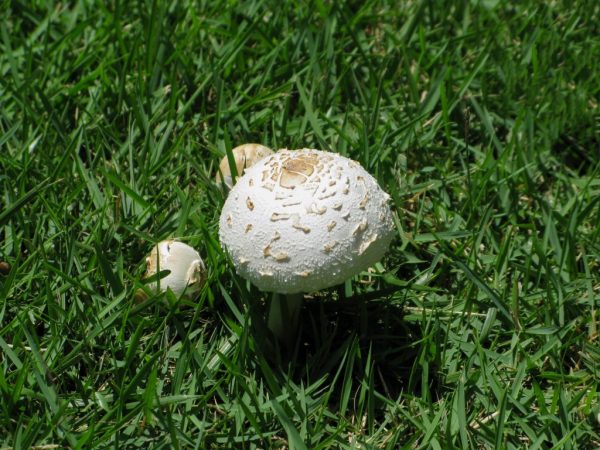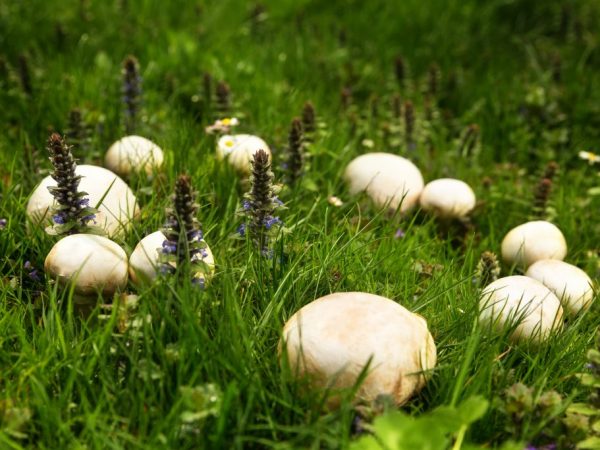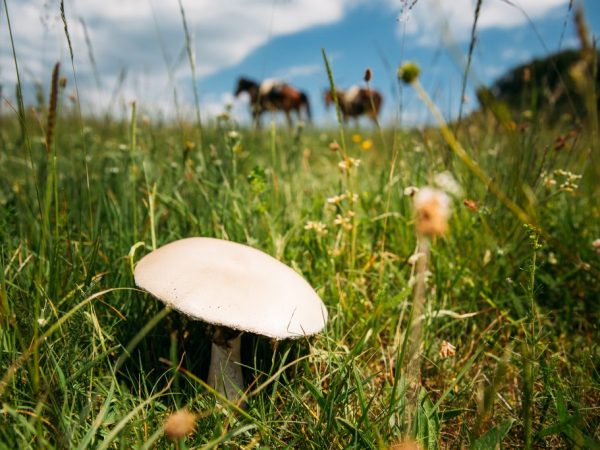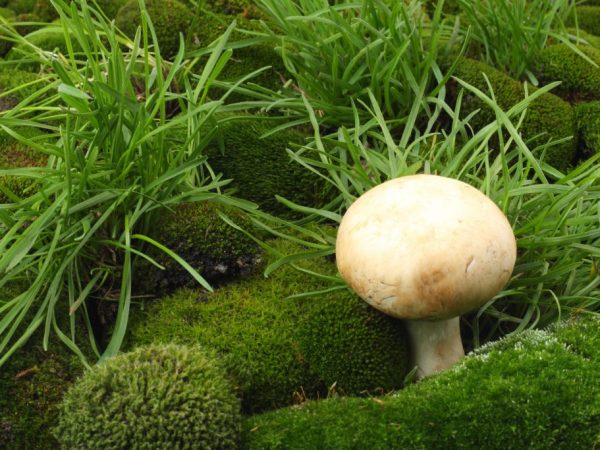Types of meadow champignon
Those who do not like to delve into the thickets of the forest, the meadow mushroom is of particular interest. It grows in open meadows, garden and summer cottages, near houses and farms - in general, where we most often visit by the nature of our activity or place of residence.

Types of meadow champignon
Description
The word "Champignon", translated from French means "mushroom".
Hat:
- diameter - from 7 to 17 cm;
- shape - regular, rounded, with a characteristic bulge;
- the color is gray-brown;
- membranes (hymenophore plates) are thin, transparent, densely spaced;
- spores are gray-black.
Leg:
- height - 9-11 cm;
- diameter about 2 cm;
- shape - cylinder;
- the ring is thin-membranous.
Pulp:
- the structure is dense;
- White color;
- the smell characteristic of champignon.
Changes during growth
In the process of intensive growth, the leg quickly thickens, the structure becomes denser, the upper skin acquires a pinkish or yellowish tint.
The hat becomes rough and hard when it reaches biological maturity. The plates gradually acquire a reddish-brown color.
The meadow mushroom never grows alone - its biology excludes this. It forms groups in the form of rings, which are also called "forest bracelet" or "witch's rings". Human-cultivated lands are the most suitable habitat for ovens (popular name for meadows)
Views
Agaricus campestris, or field mushroom, has relatives that grow in similar natural conditions. These include:
- sh. ordinary;
- sh. Bernard;
- sh. two-ring.
In order for the harvested crop to bring only benefits, before going into the forest, it is important to find out which species are poisonous and how to distinguish them from edible ones.
Young champignon is often confused with pale toadstool or white amanita, which really look like this mushroom. Only meadow grass has pinkish plates, and poisonous porcini mushrooms.
Field champignon
Agaricus arvensis (wild meadow mushroom) is an edible species used in industrial culinary applications.
Hat:
- diameter - 16-20 cm;
- color white-gray or cream;
- membranes (plates) are thin, densely spaced;
- the form is egg-like during the period of technical ripeness, and bell-shaped during the biological period.
For your information. The technical ripeness of a mushroom or agricultural plant means that they have reached a certain size that allows them to be harvested.
Leg:
- height - 8-11 cm;
- diameter - 1-1.5 cm;
- the ring is two-layer.
Pulp:
- color white or yellow;
- the structure is loose.
In young specimens, the caps are characterized by the presence of curved edges. Then they become wavy and cracked. When pressed, the leg turns yellow, as does the pulp at the break. It tastes sweet and aromatic.
The species has poisonous counterparts. It is confused with pale toadstool and yellow-skinned champignon. The difference is in the smell: poisonous smells like a medicinal mixture.
Field champignon is widespread in the north of Russia, bears fruit from May to November in fields and pastures, in nettles and at the bases of spruces.
In England it is called "horse mushroom" because it is often found in manure.
Common champignon

Common champignon will delight with long fruiting
Agaricus belongs to the category of edible, fast-ripening mushrooms. During the period of technical ripeness, it has an average size.
Hat:
- diameter - 9-12 cm;
- the surface is scaly, velvety;
- the plates are strong, sparsely located.
Leg:
- height - from 8 to 11 cm;
- diameter - 1-1.5 cm.
Pulp:
- the structure is dense;
- the color is milky or beige.
In the center of the leg, a wide white ring is clearly visible, running along its perimeter. The pinkish color of the plates gradually changes to light brown. The flesh turns pink when cut.
The species pleases with its yield from May to the end of October.
Bernard's champignon

With age, the cap of the mushroom becomes flat
The official Latin name is Agaricus bernardii. The variety belongs to the edible category.
Hat:
- diameter - up to 12 cm;
- the surface is scaly, soft;
- membranes are thin, densely spaced, translucent.
Leg:
- columnar form;
- diameter up to 2 cm.
Pulp:
- dense;
- white-yellow (depending on the degree of ripeness).
Over time, the flesh turns pink, the cap is flat and cracked.
Irina Selyutina (Biologist):
Bernard's champignons are interesting for their association with saline soils. In the United States, this species is found along the entire coast, both Pacific and Atlantic, and in Denver, Colorado. They are also found in desert areas, on the so-called takyrs (dense cracked surfaces formed after the drying out of saline soils, on the surface of which small reservoirs appear from time to time during the rainy period). There, their developing fruiting bodies break through the dense crust and come to the surface. The fungus is also found along the roads, which are sprinkled with salt in winter. It is believed that this species is widespread in Europe, it can be found in the deserts of Central Asia, some time ago, representatives of the species were found in Mongolia. You can collect it from early summer until autumn.
Bernard's champignon has an external resemblance to the edible species Agaricus bitorquis, but differs in aroma. In two-ring champignon it is sourish, the ring has 2 layers.
Two-ring
Agaricus bitorquis, or two-ring champignon, is edible. Fruiting from May to late September.
Hat:
- diameter - 8-10 cm;
- the color is brown;
- the surface is rough, scaly;
- membranes are thin, translucent.
Leg:
- columnar form;
- diameter - 2 cm.
Pulp:
- dense;
- white-yellow (depending on the degree of ripeness).
The plates under the surface of the cap are frequent and with a pinkish tinge. The pulp is homogeneous, dense, does not have a pronounced aroma. The surface of the cap is usually gray or off-white.
At the break, the flesh turns pink. It is dense and homogeneous.
The second name of the mushroom is "sidewalk", because it often grows in busy streets, making its way through cracks in the asphalt.
Application

All types of champignons are suitable for consumption
All types of champignons have found their application in cooking and traditional or folk medicine.
Cooking applications
Culinary experts are happy to use peppers in hot dishes, pates or appetizers. They retain their qualities well after freezing.
These mushrooms are aromatic and delicious pickled or salted. They can also be dried for the winter.
Application in traditional medicine
Some of the types of champignons are used to prepare tinctures with a strong bactericidal effect. In ancient times, decoctions and tinctures were used in the fight against such a serious disease as typhoid fever. Now they are used for wound healing externally, they are drunk for colds.
The extract will be effective as a strong antidote for snake bites.
In the treatment of diabetes mellitus, the extract helps to lower blood sugar levels.
Contraindications
All mushrooms, and champignons are no exception in this regard, in nature they behave like sponges. They absorb heavy metals, all toxins from the air and earth. It is difficult to bring them completely into a decoction at home, so you should not collect fruit bodies near roads, factories, on city streets, etc.
"Forest meat" is difficult to digest due to the high content of chitin in the cell walls. It is especially abundant in the legs, therefore, for people suffering from diseases of the gastrointestinal tract, it is important to observe the measure and not to abuse such a product.
It is better for pregnant women to consult a gynecologist before consuming a forest delicacy.
Children under 14 years old are allowed to introduce forest organisms into their diet only after consulting a pediatrician.
Conclusion
In order for a walk in the forest and harvesting these delicious mushrooms to be beneficial, it is important to take precautions, study all edible and inedible species, and follow the cooking technology precisely.



